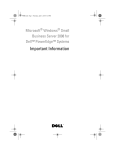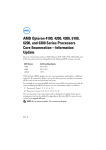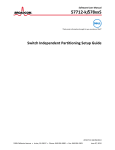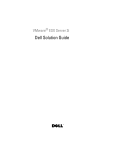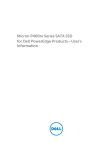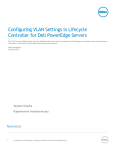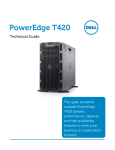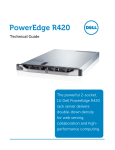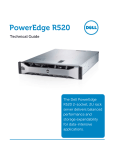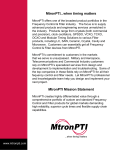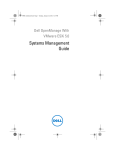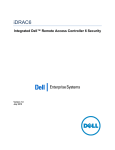Download Dell 4.x Deployment Guide
Transcript
VMware ESXi 4 on Dell PowerEdge Systems Deployment Guide Notes and Cautions NOTE: A NOTE indicates important information that helps you make better use of your computer. CAUTION: A CAUTION indicates potential damage to hardware or loss of data if instructions are not followed. ____________________ © 2009–2012 Dell Inc. Trademarks used in this text: Dell™, the DELL logo, PowerEdge™, and PowerVault™ are trademarks of Dell Inc. Intel® and Xeon® are registered trademarks and Core™ is a trademark of Intel Corporation in the U.S. and other countries. AMD® is a registered trademark and AMD Opteron™ is a trademark of Advanced Micro Devices, Inc. Microsoft®, SQL Server®, and Windows® are either trademarks or registered trademarks of Microsoft Corporation in the United States and/or other countries. Novell® and NetWare® are registered trademarks of Novell Inc. in the United States and other countries. Oracle® is a registered trademark of Oracle Corporation and/or its affiliates. VMware®, VMotion™, and vSphere™ are registered trademarks or trademarks of VMware, Inc. in the United States or other countries. 2012 - 06 Rev. A15 Contents Introduction . . . . . . . . . . . . . . . . . . . . . . . . VMware License Offerings . . . . . . . . . . . . . . 6 . . . . . . . . . . . . . 7 . . . . . . . . . . . . . . . . . 8 ESXi Architecture Overview Important Information 5 . . . . . . . . . . vSphere 4 Architecture Overview Supported Configurations 5 . . . . . . . . . . . . . . . . . . 21 . . . . . 23 Configuring vSphere 4 Using Dell Fibre Channel SAN . . . . . . . . . . . . . . . . . . . . 23 Configuring vSphere 4 Using iSCSI SAN. . . . . . . . . . . . . . . . . . . . . . 24 . . . . . . . . . . . . . 25 Supported vSphere 4 Configuration Solutions ESXi and vCenter Deployment . . . . . . . . . . . . 25 . . . . . . . . . . . . 25 . . . . . . . . . . . . . . . . . . . . 27 Guidelines for Deploying ESXi Best Practices Checklist for Deployment . . . . . . . . . Booting ESXi Configuring the Password . . . . . . . . . . . . . Configuring Lockdown Mode . . . . . . . . . . . . Configuring, Restarting, Testing, or Disabling the Management Network Services. . . . . . . . Additional Setup Steps . 29 . . . . . . . . . . 30 . . . . . . . . . . . . . . 30 . . . . . . . . . . . . . 30 . . . . . . . . . . . . . . 31 . . . . . . . . . . . . . . . . . . . . . 32 Deploying vCenter Server Installing vSphere Client Image Recovery 29 Contents 3 Creating the ESXi Recovery Media . . . . . . . . . . . . Image Recovery for ESXi Embedded Edition . . . . . . . . . . . . . . . . 32 . . . . . . . . . . . . . . 32 . . . . 33 . . . . . . . . . . . 34 . . . . . . . . . . . . 34 . . . . . . . . . . . . . . . . . . . . . 35 Configuration Backup and Restore Procedures . Backing Up the Configuration of Your ESXi Host . . . . . . . Restoring the Configuration of Your ESXi Host . . . . . . Troubleshooting Related Information 4 Contents . . . . . . . . . . . . . . . . . . . 37 Introduction This document is a companion guide to the VMware ESXi 4 guides. This document helps you to deploy ESXi 4 and provides specific information on recommended configurations, best practices, and additional resources. NOTE: For information on deploying ESX 4, see the VMware ESX 4 on Dell PowerEdge Systems Deployment Guide at support.dell.com/manuals. VMware License Offerings Dell offers the following VMware editions: • vSphere Essentials Plus • vSphere Standard • vSphere Enterprise • vSphere Enterprise Plus • vCenter Server • vSphere Standard Acceleration Kit (8 sockets) • vSphere Enterprise Acceleration Kit (6 sockets) • vSphere Enterprise Plus Acceleration Kit (6 sockets) NOTE: In addition to the above, Dell also offers ESXi Single Server edition. For information on latest ESXi editions, see vmware.com/products/vsphere/buy/editions_comparison.html. NOTE: vSphere Essentials Plus is an all-inclusive package that includes licenses for three physical systems, each system with up to two processors. It also includes VMware vCenter Server to centrally manage the systems. vSphere Essentials Plus edition is supported only on two-socket systems. The additional licenses must still be deployed on approved systems for Dell support. NOTE: vSphere Acceleration Kits are packages of vSphere licenses plus a vCenter Server Standard license for initial deployments. All the licenses provided are on the same VMware contract and Dell support contract. The additional licenses must be deployed on approved systems for Dell support. If you have ordered ESXi with your PowerEdge system, ESXi is pre-installed and pre-activated with the Single Server edition license key. Ensure that you note down the license key. ESXi Deployment Guide 5 If you have ordered ESXi hypervisor-based vSphere Essentials Plus, Standard, Enterprise, or Enterprise Plus, replace the Single Server edition license key with the purchased one. vSphere 4 Architecture Overview Figure 1. vSphere Components vSphere Client/vSphere CLI vCenter Server PowerEdge System as ESXi Host Ethernet Fabric Storage Interconnect Fabric License Server vCenter Server Database vSphere infrastructure consists of the following components: 6 • ESXi — Allows multiple operating systems to run simultaneously on a single system. • vCenter Server — Runs on Windows-based operating systems and monitors and manages Virtual Machines (VMs) and copies of ESXi. With vCenter Server, you can create, start, stop, and migrate VMs across the entire physical data center. vCenter Server is optional and is required ESXi Deployment Guide for advanced management capabilities such as VMware VMotion, Distributed Resource Scheduling (DRS), and High Availability (HA). For more information, see "Deploying vCenter Server" on page 33. • vCenter Server Database — Stores all the configuration data about a VMware infrastructure environment. It is recommended that you use a production database such as Microsoft SQL Server or Oracle for the vCenter Server database. • License Server — Required if vCenter Server manages ESX 3.0.x/ESXi 3.5 hosts. It is recommended that you install the license server on the vCenter Server host. This can also reside on a separate host. The license server is required when using a centralized licensing model, but is not required for host-based licensing. • vSphere Client — Required to manage an ESXi host by directly connecting to it or through the vCenter Server. Installs on a system running a supported Windows operating system. • VM DataStore — Stores VM configuration and virtual disk files. The VM storage can either be an internal storage local to the ESXi or an external storage that can be shared by multiple ESXi systems. Advanced features such as VMotion, HA, and DRS require that the disk and configuration files are stored on external shared storage. • vSphere CLI — Performs operations that are performed using ESX Server 4 Service Console. vSphere CLI commands can be used in scripts that run on ESX/ESXi 4 hosts. vSphere CLI commands are useful for an ESXi 4 host, because the ESXi 4 host does not include a service console. ESXi Architecture Overview ESXi is a bare-metal enterprise class hypervisor, which is pre-installed on PowerEdge systems. With the reduced footprint of the hypervisor, ESXi is integrated on PowerEdge systems through embedded Secure Digital (SD). Integrated virtualization by VMware offers: • Ease of deployment • Integrated hardware monitoring • Enhanced security • Reduced patch management • Improved reliability ESXi Deployment Guide 7 Figure 2. ESXi 4 Architecture Supported Configurations For complete information about all the supported Dell PowerEdge systems with ESXi, see VMware ESX/ESXi 4.x on Dell PowerEdge Systems and Storage Compatibility Matrix at support.dell.com/manuals. NOTE: SAS/SATA drives mentioned under Table 1, Table 2, and Table 3 also include SSDs. 8 ESXi Deployment Guide Table 1 lists the currently shipping modular-based Dell PowerEdge systems that support ESXi Embedded. Table 1. Modular-Based PowerEdge Systems PowerEdge M820 Configuration Processors Intel Xeon E5-4600 product family Minimum Memory 4 GB Internal Storage Up to four 2.5 inch SAS/SATA disks Internal Flash Memory Supported SD memory card Internal Storage Adapter PowerEdge RAID Controller (PERC) H310, PERC H710, and PERC H710P External Disk Storage Adapter Not applicable Fibre Channel HBA All supported HBAs Networking BCM 57810S bNDC, Intel X520 bNDC, Qlogic QMD8262-k bNDC, and supported peripheral NICs Remote Access Integrated Dell Remote Access Controller(iDRAC)7 PowerEdge M620 Configuration Processors Intel Xeon E5-2600 product family Minimum Memory 4 GB Internal Storage Up to two 2.5 inch SAS/SATA disks Internal Flash Memory Supported SD memory card Internal Storage Adapter PERC H310, PERC H710, and PERC H710P External Disk Storage Adapter Not applicable Fibre Channel HBA All supported HBAs Networking BCM 57810S bNDC, Intel X520 bNDC, Qlogic QMD8262-k bNDC, and supported peripheral NICs Remote Access iDRAC7 ESXi Deployment Guide 9 Table 1. Modular-Based PowerEdge Systems (continued) PowerEdge M520 Configuration Processors Intel Xeon E5-2400 product family Minimum Memory 4 GB Internal Storage Up to two 2.5 inch SAS/SATA disks Internal Flash Memory Supported SD memory card Internal Storage Adapter PERC H310 Mini Blade, PERC H710 Mini Blade, and PERC H710P Mini Blade External Disk Storage Adapter Not applicable Fibre Channel HBA All supported HBAs Networking Four integrated network ports and all supported peripheral NICs Remote Access iDRAC7 PowerEdge M420 Configuration Processors Intel Xeon E5-2400 product family Minimum Memory 4 GB Internal Storage Up to two 1.8 inch uSATA drive Internal Storage Adapter PERC H310 adapter External Disk Storage Adapter Not applicable Fibre Channel HBA (SAN connectivity) All supported HBAs Networking Two integrated network ports and all supported peripheral NICs Remote Access iDRAC7 10 ESXi Deployment Guide Table 1. Modular-Based PowerEdge Systems (continued) PowerEdge M915 Configuration Processors AMD Opteron 6100/6200 series Minimum Memory 4 GB Internal Storage Two 2.5 inch SAS/SATA disks Internal Storage Adapter PERC H200 Modular and PERC H700 Modular External Disk Storage Adapter Not applicable Fibre Channel HBA (SAN connectivity) All supported HBAs Networking Four 1 GbE or 10 GbE integrated network ports and all supported peripheral NICs Remote Access iDRAC6 PowerEdge M910 Configuration Processors Intel Xeon 6500 series or Intel Xeon 7500 series or Intel Xeon E7-2800/4800/8800 product family Minimum Memory 4 GB Internal Storage Two 2.5 inch SAS/SATA disks Internal Flash Memory Supported SD memory card Internal Storage Adapter PERC H200 Modular and PERC H700 Modular External Disk Storage Adapter Not applicable Fibre Channel HBA (SAN connectivity) All supported daughter cards Networking Four integrated network ports and all supported peripheral NICs Remote Access iDRAC6 ESXi Deployment Guide 11 Table 1. Modular-Based PowerEdge Systems (continued) PowerEdge M710HD Configuration Processors Intel Xeon 5500/5600 series Minimum Memory 4 GB Internal Storage Up to four 2.5 inch SAS/SATA disks Internal Flash Memory Supported SD memory card Internal Storage Adapter PERC H200 Embedded External Disk Storage Adapter Not applicable Fibre Channel HBA (SAN connectivity) All supported daughter cards Networking Four 1 GbE or two 10 GbE integrated network ports and all supported peripheral NICs Remote Access iDRAC6 PowerEdge M710 Configuration Processors Intel Xeon 5500/5600 series Minimum Memory 4 GB Internal Storage Up to four 2.5 inch SAS/SATA disks Internal Flash Memory Supported SD memory card Internal Storage Adapter SAS 6/iR Integrated, Cost-Effective RAID Controller (CERC) 6/i, PERC 6/i Integrated, PERC H200 Modular, and PERC H700 Modular External Disk Storage Adapter Not applicable Fibre Channel HBA (SAN connectivity) All supported daughter cards Networking Four integrated network ports and all supported NIC daughter cards Remote Access iDRAC6 12 ESXi Deployment Guide Table 1. Modular-Based PowerEdge Systems (continued) PowerEdge M610x Configuration Processors Intel Xeon 5500/5600 series Minimum Memory 4 GB Internal Storage Two 2.5 inch SAS/SATA disks Internal Flash Memory Supported SD memory card Internal Storage Adapter PERC H200 Modular and PERC H700 Modular External Disk Storage Adapter PERC H800 Fibre Channel HBA (SAN connectivity) All supported daughter cards Networking Four integrated network ports and all supported NIC daughter cards Remote Access iDRAC6 PowerEdge M610 Configuration Processors Intel Xeon 5500/5600 series Minimum Memory 4 GB Internal Storage Two 2.5 inch SAS/SATA disks Internal Flash Memory Supported SD memory card Internal Storage Adapter SAS 6/iR Integrated, CERC 6/i, PERC 6/i Integrated, PERC H200 Modular, and PERC H700 Modular External Disk Storage Adapter Not applicable Fibre Channel HBA (SAN connectivity) All supported daughter cards Networking Two integrated network ports and all supported NIC daughter cards Remote Access iDRAC6 ESXi Deployment Guide 13 Table 2 lists the currently shipping rack-based Dell PowerEdge systems that support ESXi Embedded. Table 2. Rack-Based PowerEdge Systems PowerEdge R820 Configuration Processors Intel Xeon E5-4600 product family Minimum Memory 4 GB Internal Storage Up to sixteen 2.5 inch SAS/SATA disks Internal Flash Memory Supported SD memory card Internal Storage Adapter PERC H310, PERC H710, and PERC H710P External Disk Storage Adapter PERC H810, 6Gbps SAS HBA Fibre Channel HBA All supported HBAs Networking Broadcom 57800S QP rNDC, Broadcom 5720 QP rNDC, Intel X540 QP rNDC, Intel i350 rNDC, and supported peripheral NICs Remote Access iDRAC7 PowerEdge R720 Configuration Processors Intel Xeon E5-2600 product family Minimum Memory 4 GB Internal Storage Up to sixteen 2.5 inch or eight 3.5 inch SAS/SATA disks Internal Flash Memory Supported SD memory card Internal Storage Adapter PERC H310, PERC H710, and PERC H710P External Disk Storage Adapter PERC H810, 6Gbps SAS HBA Fibre Channel HBA All supported HBAs Networking Broadcom 57800S QP rNDC, Broadcom 5720 QP rNDC, Intel X540 QP rNDC, Intel i350 rNDC, and supported peripheral NICs Remote Access iDRAC7 14 ESXi Deployment Guide Table 2. Rack-Based PowerEdge Systems (continued) PowerEdge R720xd Configuration Processors Intel Xeon E5-2600 product family Minimum Memory 4 GB Internal Storage Up to twenty-six 2.5 inch or twelve 3.5 inch SAS/SATA disks Internal Flash Memory Supported SD memory card Internal Storage Adapter PERC H310, PERC H710, and PERC H710P External Disk Storage Adapter PERC H810, 6Gbps SAS HBA Fibre Channel HBA All supported HBAs Networking Broadcom 57800S QP rNDC, Broadcom 5720 QP rNDC, Intel X540 QP rNDC, Intel i350 rNDC, and supported peripheral NICs Remote Access iDRAC7 PowerEdge R620 Configuration Processors Intel Xeon E5-2600 product family Minimum Memory 4 GB Internal Storage Up to ten 2.5 inch SAS/SATA disks Internal Flash Memory Supported SD memory card Internal Storage Adapter PERC H310, PERC H710, and PERC H710P External Disk Storage Adapter PERC H810, 6Gbps SAS HBA Fibre Channel HBA All supported HBAs Networking Broadcom 57800S QP rNDC, Broadcom 5720 QP rNDC, Intel X540 QP rNDC, Intel i350 rNDC, and supported peripheral NICs Remote Access iDRAC7 ESXi Deployment Guide 15 Table 2. Rack-Based PowerEdge Systems (continued) PowerEdge R520 Configuration Processors Intel Xeon E5-2400 product family Minimum Memory 4 GB Internal Storage Up to eight 3.5 inch or 2.5 inch SAS/SATA disks Internal Flash Memory Supported SD memory card Internal Storage Adapter PERC H710, PERC H710P, and PERC H310 adapters External Disk Storage Adapter PERC H810 adapter Fibre Channel HBA All supported HBAs Networking Two integrated network ports and all supported peripheral NICs Remote Access iDRAC7 PowerEdge R420 Configuration Processors Intel Xeon E5-2400 product family Minimum Memory 4 GB Internal Storage Up to eight 2.5 inch or four 3.5 inch SAS/SATA disks Internal Flash Memory Supported SD memory card Internal Storage Adapter PERC H710, PERC H710P, and PERC H310 adapters External Disk Storage Adapter PERC H810 adapter Fibre Channel HBA All supported HBAs Networking Two integrated network ports and all supported peripheral NICs Remote Access iDRAC7 16 ESXi Deployment Guide Table 2. Rack-Based PowerEdge Systems (continued) PowerEdge R320 Configuration Processors Intel Xeon E5-2400 product family Minimum Memory 4 GB Internal Storage Up to eight 2.5 inch or four 3.5 inch SAS/SATA disks Internal Flash Memory Supported SD memory card Internal Storage Adapter PERC H710, PERC H710P, and PERC H310 adapters External Disk Storage Adapter PERC H810 adapter Fibre Channel HBA All supported HBAs Networking Two integrated network ports and all supported peripheral NICs Remote Access iDRAC7 PowerEdge R910 Configuration Processors Intel Xeon 7500 series or Intel Xeon E7-4800/8800 product family Minimum Memory 4 GB Internal Storage Up to sixteen 2.5 inch SAS/SATA disks Internal Flash Memory Supported SD memory card Internal Storage Adapter SAS 6/iR Integrated, PERC 6/i Integrated, PERC H200 Integrated, and PERC H700 Integrated External Disk Storage Adapter SAS 5/E, 6 Gbps SAS HBA, and PERC H800 Fibre Channel HBA (SAN connectivity) All supported HBAs Networking Four integrated network ports and all supported peripheral NICs Remote Access iDRAC6 Enterprise ESXi Deployment Guide 17 Table 2. Rack-Based PowerEdge Systems (continued) PowerEdge R815 Configuration Processors AMD Opteron 6100/6200 series Minimum Memory 8 GB Internal Storage Up to six 2.5 inch SAS/SATA disks Internal Flash Memory Supported SD memory card Internal Storage Adapter PERC H200 Integrated and PERC H700 Integrated External Disk Storage Adapter SAS 5/E, 6 Gbps SAS HBA, and PERC H800 Fibre Channel HBA (SAN connectivity) All supported HBAs Networking Four integrated network ports and all supported peripheral NICs Remote Access iDRAC6 Enterprise PowerEdge R810 Configuration Processors Intel Xeon 6500 series or Intel Xeon 7500 series or Intel Xeon E7-2800/4800/8800 product family Minimum Memory 4 GB Internal Storage Up to six 2.5 inch SAS/SATA disks Internal Flash Memory Supported SD memory card Internal Storage Adapter PERC H200 Integrated and PERC H700 Integrated External Disk Storage Adapter SAS 5/E, 6 Gbps SAS HBA, and PERC H800 Networking Four integrated network ports and all supported peripheral NICs Fibre Channel HBA (SAN connectivity) All supported HBAs Remote Access iDRAC6 Enterprise 18 ESXi Deployment Guide Table 2. Rack-Based PowerEdge Systems (continued) PowerEdge R715 Configuration Processors AMD Opteron 6100/6200 series Minimum Memory 8 GB Internal Storage Up to six 2.5 inch SAS/SATA disks Internal Flash Memory Supported SD memory card Internal Storage Adapter PERC H200 Integrated and PERC H700 Integrated External Disk Storage Adapter SAS 5/E, 6 Gbps SAS HBA, and PERC H800 Fibre Channel HBA All supported HBAs Networking Four integrated network ports and all supported peripheral NICs Remote Access iDRAC6 Enterprise PowerEdge R710 Configuration Processors Intel Xeon 5500/5600 series Minimum Memory 4 GB Internal Storage Up to eight 2.5 inch or six 3.5 inch SAS/SATA disks Internal Flash Memory Supported SD memory card Internal Storage Adapter PERC 6/i Integrated, SAS 6/iR Integrated, PERC H200 Integrated, and PERC H700 Integrated External Disk Storage Adapter SAS 5/E, PERC 6/E, 6 Gbps SAS HBA, and PERC H800 Fibre Channel HBA All supported HBAs Networking Four integrated network ports and all supported peripheral NICs Remote Access iDRAC6 Enterprise ESXi Deployment Guide 19 Table 2. Rack-Based PowerEdge Systems (continued) PowerEdge R610 Configuration Processors Intel Xeon 5500 /5600 series Minimum Memory 4 GB Internal Storage Up to six 2.5 inch SAS/SATA disks Internal Flash Memory Supported SD memory card Internal Storage Adapter SAS 6/iR Integrated, PERC 6/i Integrated, PERC H200 Integrated, and PERC H700 Integrated External Disk Storage Adapter SAS 5/E, PERC 6/E, 6 Gbps SAS HBA, and PERC H800 Fibre Channel HBA All supported HBAs Networking Four integrated network ports and all supported peripheral NICs Remote Access iDRAC6 Enterprise PowerEdge R510 Configuration Processors Intel Xeon 5500/5600 series Minimum Memory 2 GB Internal Storage Up to twelve 3.5 inch SAS/SATA disks Internal Flash Memory Supported internal USB memory key Internal Storage Adapter SAS 6i/R Integrated, PERC 6/i Integrated, PERC H200 Integrated, and PERC H700 Integrated NOTE: The x12 backplanes support only PERC H200 and PERC H700 adapters. External Disk Storage Adapter SAS 5/E, PERC 6/E, 6 Gbps SAS HBA, and PERC H800 Fibre Channel HBA (SAN connectivity) All supported HBAs Networking Two integrated network ports and all supported peripheral NICs Remote Access iDRAC6 Enterprise 20 ESXi Deployment Guide Table 3 lists the currently shipping tower-based PowerEdge systems that support ESXi Embedded. Table 3. Tower-Based PowerEdge Systems PowerEdge T620 Configuration Processors Intel Xeon E5-2600 product family Minimum Memory 4 GB Internal Storage Up to twenty-four 2.5 inch or twelve 3.5 inch SAS/SATA disks Internal Flash Memory Supported SD memory card Internal Storage Adapter PERC H710, PERC H710P, and PERC H310 External Disk Storage Adapter PERC H810, 6Gbps SAS HBA Fibre Channel HBA All supported HBAs Networking Two integrated network ports and all supported peripheral NICs Remote Access iDRAC7 PowerEdge T420 Configuration Processors Intel Xeon E5-2400 product family Minimum Memory 2 GB Internal Storage Up to sixteen 2.5 inch or eight 3.5 inch SAS/SATA disks Internal Flash Memory Supported SD memory card Internal Storage Adapter PERC H710, PERC H710P, and PERC H310 External Disk Storage Adapter PERC H810 Fibre Channel HBA All supported HBAs Networking Two integrated network ports and all supported peripheral NICs Remote Access iDRAC7 ESXi Deployment Guide 21 Table 3. Tower-Based PowerEdge Systems (continued) PowerEdge T320 Configuration Processors Intel Xeon E5-2400 product family Minimum Memory 2 GB Internal Storage Up to sixteen 2.5 inch or eight 3.5 inch SAS/SATA disks Internal Flash Memory Supported SD memory card Internal Storage Adapter PERC H710, PERC H710P, and PERC H310 External Disk Storage Adapter PERC H810 Fibre Channel HBA All supported HBAs Networking Two integrated network ports and all supported peripheral NICs Remote Access iDRAC7 PowerEdge T710 Configuration Processors Intel Xeon 5500/5600 series Minimum Memory 2 GB Internal Storage Up to sixteen 2.5 inch or up to eight 3.5 inch SAS/SATA disks Internal Flash Memory Supported SD memory card Internal Storage Adapter PERC 6/i Integrated, SAS 6/iR Integrated, PERC H200 Integrated, and PERC H700 Integrated External Disk Storage Adapter SAS 5/E, PERC 6/E, 6 Gbps SAS HBA, and PERC H800 Fibre Channel HBA (SAN connectivity) All supported HBAs Networking Two integrated network ports and all supported peripheral NICs Remote Access iDRAC6 Enterprise 22 ESXi Deployment Guide Table 3. Tower-Based PowerEdge Systems (continued) PowerEdge T610 Configuration Processors Intel Xeon 5500/5600 series Minimum Memory 4 GB Internal Storage Up to eight 2.5 inch or 3.5 inch SAS/SATA disks Internal Flash Memory Supported SD memory card Internal Storage Adapter SAS 6/iR Integrated, PERC 6/i Integrated, PERC H200 Integrated, and PERC H700 Integrated External Disk Storage Adapter SAS 5/E, PERC 6/E, 6 Gbps SAS HBA, and PERC H800 Fibre Channel HBA (SAN connectivity) All supported HBAs Networking Two integrated network ports and all supported peripheral NICs Remote Access iDRAC6 Enterprise ESXi Deployment Guide 23 Important Information 24 • PowerEdge systems shipped with BCM 5709 LOMs (with iSCSI offload enabled through the hardware key) support iSCSI Boot Firmware Table (iBFT). • PowerEdge systems shipped with Intel Xeon 5600 series processor and later support Intel Trusted Execution Technology (TXT) with the latest shipping BIOS. • While installing ESXi on a PowerEdge system, ensure that iDRAC vFlash is disabled. When vFlash is enabled, iDRAC may expose different USB partitions to ESXi which may result in an installation failure. • When ESXi is installed on a PowerEdge R815 system, the keyboard and mouse do not function if you connect them to the top USB port on the back panel of the system. To resolve the issue, do not use the top USB port on the back panel of the system. Alternatively, you may use iDRAC vKVM to install ESXi. • On a PowerEdge R815 system, iDRAC vKVM I/O devices such as the mouse and keyboard may not respond after booting into ESXi. To resolve the issue, use the VMware patch ESXi400-201003001.zip from downloads.vmware.com. For more information, see kb.vmware.com/kb/1019834. • You cannot automatically pre-activate the Microsoft Windows Server 2008 operating system installed on VMs by using the product activation code in the Dell OEM installation media. You must use a virtual product key to activate the guest operating system. For more information, see the whitepaper, Dell OEM Windows Server 2008 Installation on Virtual Machines Using Dell OEM Media at dell.com. • The ESXi image pre-installed on your PowerEdge system may not contain all the drivers required for peripherals. Additional drivers need to be installed to enable certain add-on peripherals. You can download the drivers from support.vmware.com. • Storage Logical Unit Numbers (LUNs) (Internal Storage) are supported only with PERC-hardware-based RAID configurations. ESXi Deployment Guide • On some systems under heavy networking and processor load, the network adapter stops functioning. This leads to communication failure between the external network and the corresponding port group(s). • The VM, VMkernel, or Management Network traffic configured for the port group(s) fails. To resolve this issue, download the file ESXi400201002001 from support.vmware.com/selfsupport/download/. For more information, see kb.vmware.com/kb/1017465. • If you did not order ESXi with your system, you can order the Internal Dual SD Module kit at dell.com and download the ESXi installation media from support.dell.com. For information on how to install and setup ESXi, see the VMware vSphere 4 on Dell PowerEdge Systems Getting Started Guide at support.dell.com/manuals. • For information on Qlogic CNA driver, go to downloads.vmware.com. Under Datacenter & Cloud Infrastructure, select VMware vSphere. The downloads page for latest version of VMware vSphere is displayed. For older versions, you can select the specific link in the same page. • ESXi installation using the DRAC/iDRAC virtual media is supported. You must use Dell-customized ESXi images available at support.dell.com. • On Non-Uniform Memory Access (NUMA) enabled systems installed with ESXi, it is recommended that you populate all processor nodes with similar memory to enable balanced distribution of memory across nodes. With unbalanced memory distribution across nodes, you may face performance degradation issues or ESXi may fail to boot. The following error message may be displayed: The BIOS reports that NUMA node X has no memory. This problem is either caused by a bad BIOS or a very unbalanced distribution of memory modules. NOTE: For more information about NUMA, see VMware knowledge base articles: kb.vmware.com/kb/1003690 and kb.vmware.com/kb/1570. Also, see VMware's Resource Management Guide for vSphere 4 at vmware.com/support/pubs/. • ESXi requires a minimum system memory of 2 GB on all supported systems. ESXi Deployment Guide 25 Supported vSphere 4 Configuration Solutions This section discusses the vSphere 4 configurations with PowerEdge systems using Fibre Channel SAN and iSCSI SAN. Configuring vSphere 4 Using Dell Fibre Channel SAN Figure 3 shows vSphere 4 configuration using Fibre Channel SAN. If you use Fibre Channel storage, you can connect a single Fibre Channel HBA to a Fibre Channel switch that provides paths to both storage processors (SPs) on the Fibre Channel storage unit. To provide maximum protection against a single failure at the HBA, Fibre Channel switch, or SP level, it is recommended that you use two Fibre Channel HBAs on the ESXi host connected to separate Fibre Channel switches. The Fibre Channel switches provide redundant paths to the SPs on the storage unit. Figure 3. Configuring vSphere 4 Using Dell Fibre Channel SAN vCenter Server VMware vSphere Client Ethernet Fabric ESXi Hosts ESXi Hosts Fibre Channel Switch Dell Storage 26 ESXi Deployment Guide vCenter Server Database Redundant Fibre Channel Switch Dell Storage Configuring vSphere 4 Using iSCSI SAN Figure 4 shows a vSphere 4 configuration using iSCSI SAN. The iSCSI SAN provides a cost-effective solution. It is recommended to use two iSCSI initiators on the ESXi host connected to two separate ethernet switches to provide redundant paths to the storage processors on the storage system. Figure 4. Configuring vSphere 4 With iSCSI SAN VMware vSphere Client vCenter Server Ethernet Fabric ESXi Hosts ESXi Hosts Ethernet Switch Dell Storage Redundant Ethernet Switch Dell Storage NOTE: For more information on Dell-supported storage arrays on VMware, see VMware ESX/ESXi 4 on Dell PowerEdge Systems and Storage Compatibility Matrix at support.dell.com/manuals. ESXi Deployment Guide 27 ESXi and vCenter Deployment Guidelines for Deploying ESXi Before deploying ESXi: • Determine the licensing mode that best suits the deployment environment and design the licensing infrastructure accordingly. • Determine the kind of storage (local SCSI/SAS/SATA, iSCSI, or Fibre Channel SAN) for hosting VMs that suits the deployment environment and design your storage infrastructure accordingly. • Determine the number of LUNs, size of the LUNs, RAID level of the LUNs, and the number of storage groups. • Determine the number of VMs that run on ESXi and their corresponding workloads. • Determine the resource requirements for the VMs, such as the processor requirements, memory size, and networking. For articles on performance and sizing, see vmware.com/support/pubs. • Determine the required network information such as IP addresses, network masks, and gateway addresses. • Determine the hosts that are a part of the DRS or the HA cluster and allocate shared storage accordingly. • Determine the appropriate networking configuration for management, VMs, and iSCSI (optional). You can use Virtual Local Area Networks (VLANs) to isolate the traffic efficiently. Best Practices Checklist for Deployment 1 Rack and connect your PowerEdge system according to your system documentation. 2 Turn off your system and follow the steps below: 28 a Connect your ESXi management network to the first onboard network adapter. b Connect your VM network to the second onboard network adapter. ESXi Deployment Guide c Optionally, connect your iSCSI-based network connection to the third onboard network adapter (if applicable). For systems with only two onboard network adapters and not purchased with a network adapter, it is recommended that you add a supported network adapter. 3 Turn on your system and follow the steps below: a To enter the system setup, press <F2> when you turn on the system. For more information, see the documentation that shipped with your system. b Enable the Virtualization Technology (VT) feature, if available, in the PowerEdge system. NOTE: The VT feature is required for Intel processor based servers to run 64-bit VMs. c Set the universal serial bus (USB) controller to USB on with BIOS Support, if available, in the PowerEdge system. This setting enables support for USB devices both during and after the ESXi boot process. d Set the ESXi keyboard language. e Set the ESXi password. For more information, see "Configuring the Password" on page 32. f Set a static IP address, subnet mask, gateway, and VLAN for the management connection(s) in the Direct Console User Interface (DCUI). g Set host name and Domain Name System (DNS) settings. h Set DNS suffix(s). i Install vSphere Client to manage your system. j Replace the Single Server Edition license key with the license key that you have purchased. ESXi Deployment Guide 29 Booting ESXi This section describes how to perform the basic setup of your system based on the following assumptions: • You have already connected a keyboard, monitor, and mouse. • You have connected the first onboard NIC to your management network. • Ensure that the infrastructure between the two systems is working correctly prior to working with your system and the VMware management software. To set up your system: 1 Turn on your system. 2 Press <F11> at boot and select the internal storage device as the onetime boot device located under Hard Drives in the menu. NOTE: If you ordered ESXi as the primary operating system, the boot order of the system is already set to boot from ESXi. NOTE: If you ordered ESXi as an included hypervisor, without technical support service and did not request a hard-disk based operating system, your system may boot to a No Operating System Found message. Set the system boot order to make the storage device containing ESXi (USB or SD card) as the first boot device. In the first phase of booting, the software loads the compressed ESXi modules into memory and a progress bar is displayed. In the second phase, the modules are expanded and executed from memory. As the modules load, the DCUI briefly displays the module names on the screen. After all ESXi modules have expanded and executed, the system is ready to begin servicing workloads as illustrated in Figure 5. If there is a Dynamic Host Configuration Protocol (DHCP) system or DHCP proxy configured on your network subnet, ESXi displays the address acquired by the DHCP system. NOTE: When the address is being acquired, 0.0.0.0 is displayed by default. To install vSphere Client, see "Installing vSphere Client" on page 34. 30 ESXi Deployment Guide If a warning is displayed, the ESXi host was unable to obtain an IP address from your DHCP system. For information on configuring the setting, see "Configuring the Password" on page 32. NOTE: By default, ESXi does not have a password. It is recommended that you set a keyboard language and a system password. For more information on configuring these settings, see "Configuring the Password" on page 32. Figure 5. ESXi (Running With DHCP) Figure 6. ESXi (Running With DHCP, no Address) ESXi Deployment Guide 31 Configuring the Password You can use DCUI to set the password for the administrator account. The administrative user name for the ESXi 4 host is root. By default, the administrative password is not set. To set the password: 1 Press <F2> in the main ESXi Server host screen that is displayed after your system boots. The main DCUI configuration screen is displayed. 2 Select Configure Password and then press <Enter>. By default, the old password field is grayed out and the new password field is enabled. Enter the new password twice. If the password is accepted, the main DCUI screen is displayed. The new password is now set. 3 Press <Esc> to logout. Configuring Lockdown Mode Lockdown mode prevents remote personnel from logging in to the ESXi host by using the root login name. By default, lockdown mode is disabled. If you enable lockdown mode and do not configure other local host user accounts to have standalone host access through the vSphere Client, the root user does not have access through the vSphere API and CLI. You can still access the host through the direct console or through an authorized, centralized management application, such as vCenter Server. To configure lockdown mode: 1 Select Configure Lockdown Mode and press <Enter>. 2 Press the spacebar to select Enable Lockdown Mode and press <Enter>. 3 Press <Enter>. 32 ESXi Deployment Guide Configuring, Restarting, Testing, or Disabling the Management Network Services The ESXi 4 kernel supports IPv4, IPv6, and IEEE 802.1Q (VLAN tagging) for all management network connections; configuration of these parameters including IP address, gateway, subnet mask, host name, and DNS systems occurs through the DCUI. All VM network configuration is performed from the VMware management software. VM networks configurations from the DCUI is not supported. 1 Press <F2> in the main ESXi Server host screen that is displayed after your system boots. The main DCUI configuration screen is displayed. 2 Select Configure Management Network in the main DCUI customization screen, and press <Enter>. The Management network configuration screen is displayed. NOTE: For the PowerEdge M-series modular systems enabled with FlexAddress, ensure that the variable Net.FollowHardwareMac is set to 1. Use the vSphere Client to connect to the ESXi host. Navigate to Configuration Software Advanced Settings Net. Set Net.FollowHardwareMac to 1 and reboot the ESXi host. Additional Setup Steps 1 Backup your configuration settings using the procedures outlined in "Configuration Backup and Restore Procedures" on page 36. 2 Record your license key. NOTE: For more information, see VMware vSphere 4 on Dell PowerEdge Systems Getting Started Guide at support.dell.com/manuals. Deploying vCenter Server Beyond the basic configuration of management connectivity, ESXi requires a second Windows management station for configuration and day-to-day management. You can manage ESXi by directly connecting the system through vSphere Client or by adding the system to vCenter Server. vCenter Server provides many-to-many management of more than one copy of ESXi software. ESXi Deployment Guide 33 vSphere Client is available free of charge with ESXi (and ESX) products. You may download and use the trial version of vCenter Server. To continue using vCenter Server beyond the trial period, you must purchase a vCenter Server license. For more information on vCenter Server and configuring the one-to-many management, see the vCenter Server documentation at vmware.com/support/pubs/. Installing vSphere Client 1 Download vSphere Client directly from your ESXi server host. Point the web browser of your Windows management system to the IP address of your ESXi server host. The IP address of your system is displayed on the main screen of your system. The browser displays a webpage. 2 Click on the Download VMware vSphere Client link and install the client software. 3 After the download is complete, launch the VMware vSphere Client by specifying the IP address of your ESXi Server host, a user name of root (default), and the password you specified in "Configuring the Password" on page 32. NOTE: The password field is blank by default. If you did not specify a password in the DCUI, leave the password field blank. You receive a certificate warning indicating that the SSL certificate is not trusted and communication cannot be secured. You receive this notification because your host does not have a public key from VMware. 4 Click Ignore to proceed. To ignore this warning always, select the Always Ignore check box. 34 ESXi Deployment Guide Image Recovery The procedure described in this section restores your system to a bootable state, but does not restore the per-system licensing activation information. If you have a valid support subscription, Dell Support can help you with the reimaging process and any licensing issues. Contact Dell Support through your typical support channels or through support.dell.com. If you require a new license from Dell Support, but need to have the system up and running as soon as possible, you may use the one-time 60-day trial of all enterprise-level features including HA, DRS, and vCenter Server. To ensure you have your new license before the 60-day trial period expires, it is recommended to request the new license as soon as possible following an image recovery. This process takes less than 60 days. Creating the ESXi Recovery Media You can download the Dell customized ESXi Recovery image from support.dell.com. To download the ESXi Recovery media: 1 Go to support.dell.com and select your line of business. 2 Enter the Service Tag or the Express Service Code of the system you want to install ESXi on, and click Submit. 3 Alternatively, you can select Choose from a list of all Dell products and click Continue. 4 Select product type Servers, Storage, & NetworkingPowerEdge. 5 Select the model of your system. The Drivers & Download page is displayed. 6 Choose the Operating system as ESXi 4.0. 7 Select Enterprise Solutions and download the Dell customized ESXi ISO image. 8 Burn the ISO image to a blank media. Image Recovery for ESXi Embedded Edition Image recovery reinstalls or recovers the ESXi embedded image. To perform image recovery for flash-based systems: 1 Insert the ESXi Recovery media into the optical drive. ESXi Deployment Guide 35 2 Remove all the USB-based storage devices on the system except the device (USB key/SD card) where ESXi is installed. NOTE: ESXi recovery process fails if more than one USB storage devices are present in the system. 3 Turn on the system and press <F11> (one-time boot menu) during the POST. The system displays Entering Boot Menu… in the upper right corner of the screen. Continue with the POST process. After the initial boot is complete, a text menu of all bootable storage devices is displayed. 4 Select the optical drive where your recovery media is located. For internal optical drives, select the device and press <Enter>.The recovery environment starts. Follow the on-screen instructions to complete the recovery process. NOTE: If you see a fatal error, double check that no other USB-based storage devices are connected to the system. The system reboots and launches ESXi. If this does not happen, reassign the order of your boot devices placing the internal storage highest in the boot order list. For more information, see the manual that shipped with your system. 5 Set the correct licensing mode. For more information on licensing, see VMware vSphere 4 on Dell PowerEdge Systems Getting Started Guide at support.dell.com/manuals. 6 After reimaging, reconfigure ESXi and import any VMs you want to run on this system. Configuration Backup and Restore Procedures It is recommended that you back up your ESXi configuration after you complete the initial setup on a routine schedule that fits your datacenter environment. Backing up your configuration captures the license code (host serial number). You need the license code if you use the Recovery media to restore the ESXi image. To backup or restore the configuration information, you must use the vSphere Command Line Interface (vSphere CLI). The vSphere CLI is available as: 36 ESXi Deployment Guide • vSphere CLI package — vSphere CLI package can be installed on either Linux or on Microsoft Windows operating systems. • vSphere Management Assistant (vMA) — vMA can be deployed on an ESX/ESXi host. Both the packages are available for download at vmware.com. For information about setting up and running the vSphere CLI, see the VMware vSphere Command-Line Interface Installation and Reference Guide and VMware ESXi Embedded and vCenter Server Setup Guide at vmware.com/support/pubs. The backup and restore steps given below are on the assumption that you have already imported the vSphere CLI to a system other than the one you want to backup or restore, or that you have installed the Windows or Linux management Application Programming Interfaces (APIs). Backing Up the Configuration of Your ESXi Host To back up configuration data of a host: 1 Start the vSphere CLI. 2 Run the vicfg-cfgbackup command with the -s flag to save the host configuration to the specified backup filename. vicfg-cfgbackup --server <ESXi-host-ip> -portnumber <port_number> --protocol <protocol_type> --username root --password <root_password> [-s <backup-filename> The -portnumber and -protocol options are optional. If you exclude them, the defaults are port 443 and protocol HTTPS. NOTE: If you do not specify a password in the command line, you are prompted for one when the command executes. For example: vicfgcfgbackup --server 172.17.13.211 --username root –s backupdate.dat NOTE: If your administrative password includes special characters, such as $ or &, you must include a backslash escape character (\) before each special character. Restoring the Configuration of Your ESXi Host To restore the configuration data of a host: 1 Turn off any VMs that are running on the host you want to restore. ESXi Deployment Guide 37 2 Optionally, restore the host to the ESXi build number used when the backup file was created. The backup process does not support restoring to later builds; though, this requirement can be overridden by using the –f option. 3 Start the vSphere CLI on a host other than the host you want to restore and log in. 4 Run the vicfg-cfgbackup command with the –l flag to load and restore the backup file to the host. vicfg-cfgbackup --server <ESXi-host-IP> -portnumber <port_number> --protocol <protocol_type>-- username <username> --password <password> -l <backup_filename> The -portnumber and -protocol options are optional. If you exclude them, the defaults are port 443 and protocol HTTPS. NOTE: If you do not specify a password in the command line, you are prompted for one when the command executes. For example: vicfgcfgbackup --server 172.17.13.211 --username root –l backupdate.dat After a successful restore, the system reboots using the new configuration. For complete instructions on backup and restore commands, see the VMware ESXi Embedded and vCenter Server Setup Guide at vmware.com/support/pubs. Troubleshooting This section provides troubleshooting steps for common issues encountered during deployment of ESXi. ESXi Not Booting or Displays a “No OS found” Message at Start Up Check the boot order. The correct storage device may no longer be selected as the first boot device. This can happen if the device has recently been removed due to failure. To correct this issue, ensure that the internal storage drive on which ESXi is installed is assigned as the first boot device in the hard drive sequence and the hard drive is assigned as the first boot device in the boot sequence. 38 ESXi Deployment Guide Purple or Pink Screen While Booting or Running Your ESXi This is a sign of a serious misconfiguration or system error, similar to a blue screen for a Windows operating system or a core dump for a Linux-based system. Contact Dell Support for technical assistance. Related Information NOTE: For Dell VMware documentation and Dell systems management documentation for VMware, see support.dell.com/manuals. Navigate to Software, select Virtualization Solutions, and then VMware Software. • For information on downloading ESXi and licensing options, see VMware vSphere 4 on Dell PowerEdge Systems Getting Started Guide at support.dell.com/manuals. • For a complete list of Dell supported servers and storage, see VMware ESX/ESXi 4 on Dell PowerEdge Systems and Storage Compatibility Matrix at support.dell.com/manuals. • For known issues, see VMware vSphere 4 on Dell PowerEdge Systems Release Notes at support.dell.com/manuals. • For information on Configuration Maximums, see Configuration Maximums for VMware vSphere 4 at vmware.com/support/pubs. • For Dell|EMC-qualified storage configurations of ESXi and vCenter Server, see the EMC Support Matrix (ESM) at emc.com/interoperability. • To ensure processor compatibility across systems for VMotion, see the VMware VMotion and 64-Bit Virtual Machine support for Dell PowerEdge systems Compatibility Matrix for VMware vSphere 4 and Dell PowerEdge Systems at support.dell.com/manuals. • For the VMware vSphere 4 documents, technical resources, and knowledge base articles, see vmware.com/support. • For Hardware Compatibility Guides, see vmware.com/resources/compatibility/search.php. • For licensing information, see the VMware vSphere on Dell PowerEdge Systems Getting Started Guide at support.dell.com/manuals. ESXi Deployment Guide 39 • For information on ESXi, other Dell VMware products, technical publications including white papers, articles, and case studies, see dell.com/vmware. Technical Support Resources • vmware.com/support • dell.com/support • dell.com/services for Dell deployment and professional services Discussion Forums • vmware.com/communities/content • dellcommunity.com Knowledge Base vmware.com/support/kb Dell Wiki delltechcenter.com 40 ESXi Deployment Guide ESXi Deployment Guide 41 42 ESXi Deployment Guide ESXi Deployment Guide 43 44 ESXi Deployment Guide















































